Email marketing is one of the most effective tools for staying in touch with your customers and building responsive relationships. By providing valuable content to your email list and nurturing relationships, you will grow a loyal customer base.
We’ve taken the time to create an extensive list of the best email marketing tools available today. Use these platforms to start contacting new audiences and creating lasting connections.
The best part? You can start using them immediately!
List Of Email Marketing Tools
1. MailChimp
The winner of our top 100 email marketing tools is MailChimp! Not only is MailChimp so easy to use, but it’s fairly priced too. We’ll break down why we love it so much. Firstly, the pricing alone is enough to earn it the top spot. For a new business, it offers a free service and even for those looking to grow, it only charges $9.99 (£7.27) a month. For a premium account (the most expensive), it will cost around $299 (£217.43) a month.
Not only will MailChimp let you reach your marketing list directly, but it also offers easy to understand analytics. Everything from average open rate and average click rate, to how many subscribers in total you have. It integrates a smart mailer system, which helps you target your mail contacts with ads, site visitors or even contact those who’ve abandoned shopping carts online. It’s an intelligent system that includes adverts from your social media and Google AdWords campaigns too. The features of this tool also include making reports, that’s why it’s favoured by digital marketing agencies. The design features allow you to create unique and eye-catching emails for your mailing list, it’s functional and so easy to use.
2. Constant Contact
At number two on our list is Constant Contact. Whilst it’s hard to beat what MailChimp offer, Constant Contact are a close second! They offer a free trial for their first month, including a money back guarantee in your first month of paying if you’re not satisfied with the tool. The tool is mobile friendly, for the businesses on the go, and user reviews preach that it makes communication a lot easier with customers.
Like Mail Chimp, the service includes reporting on analytics and reach. Contacts can be imported into the system in order to not only reach your current mailing list but to help grow it. Both services offer a stock image gallery to create mail campaigns – ideal for smaller businesses who may not have the budget or backlog of stock photos. Both are equally as functional and useful, but very different. The automated functions are more limited on Constant Contact however, with MailChimp scoring the best marks overall, on every front.
3. VerticalResponse
Like MailChimp, Vertical Response offers both free and paid plans. Ranging from $11 (£8.01) – $363 (£264.23) per month. Like both the services, it allows you to send targeted emails with advanced reporting and you can test your email before it gets sent out in mass to your mailing list. This tool also utilisers autoresponders for mail, to welcome new subscribers with a customised message, as soon as they sign up. An extra feature allows you to create landing pages that complement your email campaigns. They can stand alone separate from your website and are customisable to suite and match your business. Both large, small and non-profit businesses trust VerticalResponse for their email marketing.
4. Campaign Monitor
Other than the ability to monitor a campaign (clue’s in the name), Campaign Monitor provides businesses with a method to send excellent customisable email campaigns to a full list of clients. This particular tool has a focus on personal experience for the customer. You can create eye-catching emails to go out to customers, as well as creating personal messages and scheduling mail to be delivered at the right time. Many big retail brands send out targeted emails in the later hours of the evening, to catch people who aren’t working – as they’re more likely to check low priority emails in the evening. With this in mind, Campaign Monitor still offers analytics and other features similar to the others above. Pricing ranges from $9 – $149 per month, making it great for both small and large-scale businesses.
5. Benchmark Email
Professing itself as ‘Email marketing that won’t slow you down’ on their website, Benchmark Email focuses on creative design and functionality. Like Campaign Monitor, the features of Benchmark Email are similar to the rest of the marketing tool, but design ease is favoured once more. With its useful email builder, you can design beautiful emails that draw the eye to the message and link to social pages and your website too. There are hundreds of templates available too, so you don’t need to be a graphic designer to create a stunning email for your customers.
Benchmark Email charges by the number of subscribers you wish to have on your list. With 1,000 costing $23 (£16.74), 2,500 priced at $35 (£25.48) and finally the option to reach 100,000 for $499 (£363.27) at a monthly rate. It’s ideal for smaller businesses, as you can upgrade as your business grows. Also, it’s great if you don’t have an in-house graphic design team, as you can use the templates which still look brilliant.
6. GetResponse
GetResponse differs slightly from the other services available, it’s not only for email marketing but an ‘all-in-one’ digital marketing suite. It includes email marketing, landing pages, webinars and marketing automation. Whilst some other tools offer landing pages, GetResponse includes a whole suite of functions. But, let’s focus on the email marketing – it’s what we’re here for after all… Prices range between £11 monthly and £340. You’re able to intertwine your email marketing plan with the rest of your strategy, to ensure a smooth process. With marketing tools to help you grow your mailing list, increase conversions and in turn increase audience engagement too – GetResponse is an excellent tool for mid to large-scale businesses.
7. Yesware
Yesware is another tool for the avid email marketer. Yes, it allows you to do a whole host of things that other tools allow you to do too, only it has smart email tracking tools equipped. This allows you to not only track email open and reply rates, but how many clicks on links there are, and how many attachments have been opened too. This tool has a focus on improving your selling. It helps you in the process of tracking sales and potential leads created through email marketing. It’s a handy tool for B2C businesses, to track the progress of sales through emails. You can then optimise your mail to improve selling and get more conversions.
8. iContact
Not to be confused with an apple product, iContact earns number eight on our list of email marketing tools. This affordable tool allows you to easily create emails for campaigns, and segment-specific client email lists with smart intuitive marketing automation. It also allows you to strategically follow your marketing campaign, with ROI and analytics to monitor and track conversions, clicks etc. With iContact, you’ll be able to set up customised workflows that contact the right people, with the right information. You can dive in depth with customer metrics, including their last purchase date, in order to retarget them and turn them into a returning customer. The prices range from $32 (£22.38) a month to the fully comprehensive pack at around $99 (£69.25) per month. This price makes it an ideal for small businesses with a lot of potentials to grow and expand. Not only does it integrate with all of this, but it’s design tools allow you to put together some stunning emails for campaigns.
9. MailerLite
MailerLite is used for creating more than just newsletters. It includes email automation, landing pages and pop up features too (for your website). Again, MailerLite is priced based on your desired subscriber list. With up to 1000 subscribers for free, packages range from $10 (£7), to $140 (£97.93) per month – for larger businesses. It’s a perfect way of creating a marketing strategy, looking to bring more traffic to your site, as well as boost conversion rates too. By creating optimum landing pages and pop up features, you can better reach your audience and sway them into signing up to your mailing list – to be contacted in the future. It’s a great tool to bring traffic to your website via email marketing.
10. Aweber
Finally, at number 10, we have Aweber. Like the other aforementioned tools, it allows you to directly reach the right customers on your mailing list. It includes segmentation, auto replies, reports etc. and offers customer support for the user (that’s you). With a free trial, you can try before you buy! There’s loads of great resources available to you, to help your streamline your email marketing. It’s a service like the others, but with a little extra support. The pricing ranges from $19 (£13.29) a month to around $149 (£104.23) a month, dependent on the package you want for your business.
Whilst this is our top 10 favourites, there are so many other email marketing tools available to you! See our list below for rankings from 11 – 100.
10 examples of email sender software
#1 ActiveCampaign
Best overall email marketing software
With over 130,000 customers, ActiveCampaign was the most commonly mentioned tool that survey respondents were planning to choose for email marketing software in 2022.
ActiveCampaign have earned their reputation as a leading email marketing automation tool by focusing on building a world-class product.

ActiveCampaign’s automation builder makes building automations easy, similar to using a flowchart
It’s by far the most advanced email marketing platform in our list, with machine learning and predictive tools enabling marketers to work smarter and deliver higher ROI.
Often credited for pioneering visual marketing automation, ActiveCampaign is impressively intuitive and easy-to-use compared to some of the tools on our list.
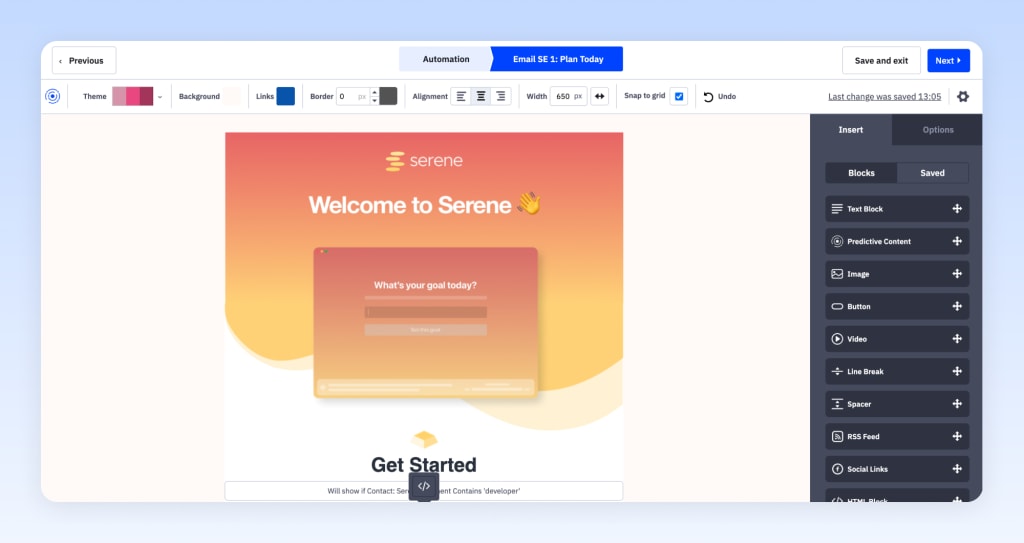
ActiveCampaign’s intuitive drag-and-drop email marketing designer
And while the tip of the iceberg that you see with ActiveCampaign is category-leading, so is what’s below the surface. Their deliverability rates are exceptional (>99%), they integrate with 870+ third-party tools, and go far above and beyond with their security and compliance measures.
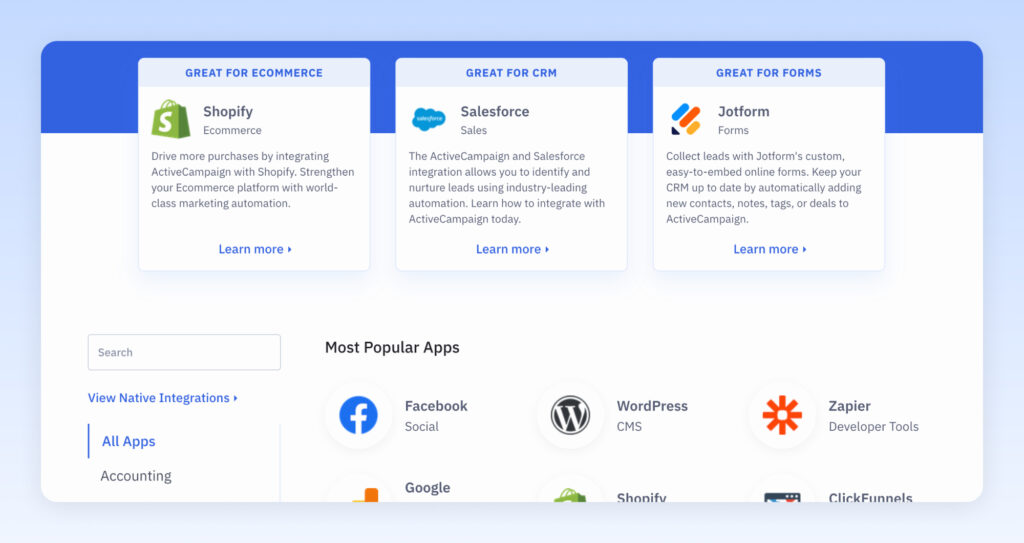
ActiveCampaign offers 870+ integrations including native integrations with Salesforce, Shopify, Google Sheets, Slack & more.
As an all-in-one sales and marketing tool, ActiveCampaign comes with an in-built CRM system to manage yours sales, live chat, and of course email marketing automation in one place.
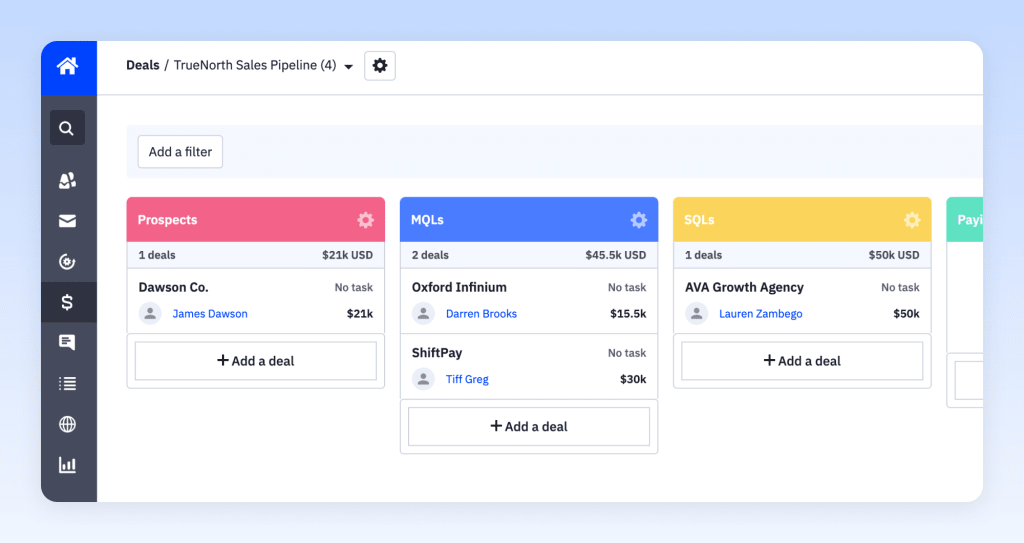
A built-in sales CRM makes it easier to manage deals, but also connects to ActiveCampaign’s powerful automation engine
You’d be forgiven for thinking all of this might come at a hefty cost. Yet, starting at $9/mo, ActiveCampaign is reasonably priced and more affordable than many of the tools in this list.
ActiveCampaign recently published their Customer Success Commitment, which outlines 22 guarantees from their support team including free implementation and migration.
ActiveCampaign’s notable features:
- 125+ Email templates
- 500+ Automation recipes
- 870+ Integrations
- Send SMS, site messages & email
- Landing pages
- CRM
- Split actions and A/B Testing
- Goal tracking, attribution & sales analytics
- Predictive content, sending & deal win probability
ActiveCampaign offers a free 14-day trial with no credit card required.
Try ActiveCampaign today.
#2 HubSpot
A good option for B2B service businesses
HubSpot is world-class in offering businesses an all-in-one sales and marketing platform that includes a CRM, landing pages, email marketing, marketing automation, chat, forms, and everything in between.
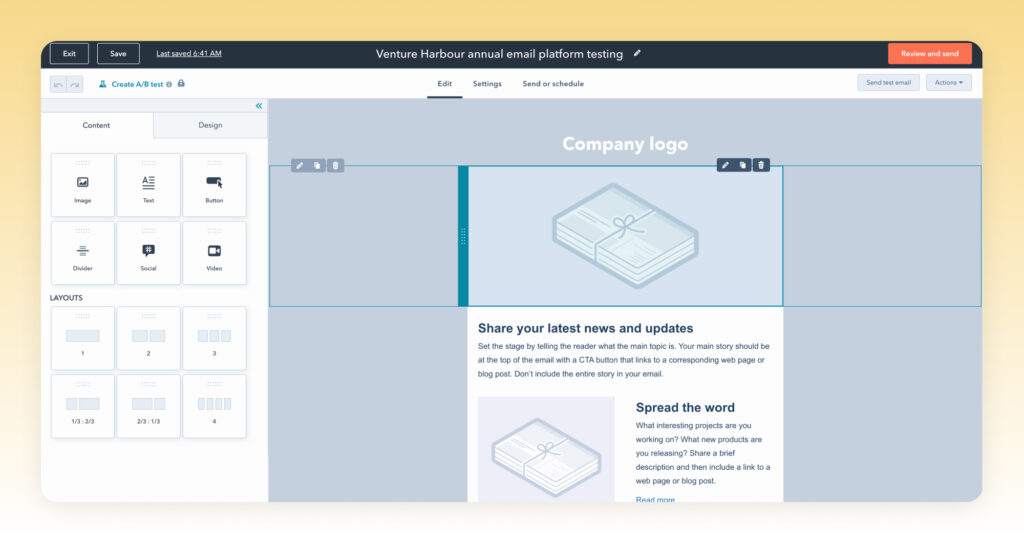
While some argue that trying to do everything is HubSpot’s downfall, it does enable them to do one thing exceptionally well; Reporting.
“Half the money I spend on advertising is wasted; the trouble is I don’t know which half.”
– John Wanamaker
By using HubSpot as the backbone of your marketing and sales, you can more easily attribute revenue back to the marketing campaign, newsletter, or blog post that influenced each sale. In this sense, HubSpot is more of a CRM that offers email marketing and automation, rather than vice versa.
And if your website is built on WordPress, then you get an extra advantage to using HubSpot as your email marketing tool. HubSpot has a WordPress plugin that gives you the ability to send email campaigns directly from WordPress. The plugin also lets you use a HubSpot form or chat widget to automatically capture contacts in your CRM, all without leaving WordPress.
Hubspot can come at a cost
While much-loved, HubSpot is the second most likely response (behind Mailchimp) to “Which email marketing software are you leaving?” in our survey of 1,700+ email marketers. The reason is almost always the same; Price.
HubSpot position themselves as an affordable option for small businesses by offering free versions of their products – but don’t be fooled by the HubSpot gateway-drug. Their platform becomes exponentially expensive as your list or feature requirements grow.
One business owner I spoke with started on a $50/month plan, and within a year needed a $2,000/month plan that had to be paid annually. The only difference was an extra 15,000 contacts and adding marketing automation, yet they jumped from seeing $50 leave the bank to $24,000.
This is where I feel conflicted about HubSpot.
On the one hand, you could get the same functionality for one-tenth of the price using ActiveCampaign, Benchmark, or half of the tools in this guide. On the other hand, if the value of knowing what influenced each sale is a problem worth paying a five-figure sum to solve, then HubSpot is a strong contender.
This is why we suggest that HubSpot is an ideal choice for B2B service companies, where the value of winning a handful of extra clients a year would easily cover the cost of HubSpot. This extends to larger, or more sophisticated, agencies that must provide clients with in-depth reports on their marketing funnel.
If you just need email marketing software, HubSpot is possibly overkill. But if your search for email marketing software is part of a wider plan to raise to your marketing game and improve performance across your entire sales and marketing funnel, HubSpot is a strong contender – but don’t expect it to come cheap.
#3 Sendinblue
A good option for transactional email
Sendinblue is best-known as one of the leading transactional email services. Building on this reputation they built an email marketing automation product.
We use Sendinblue to send transactional emails for two of our ventures (Leadformly and Serene), as they’re one of the few email marketing providers with servers in the European Union (which helps with our GDPR compliance) and they have good deliverability rates (we’re currently at 98%).
While I can’t comment on their marketing automation features from first-hand experience, it’s evident from our customer surveys that it’s good, but lacks some of the more advanced features (such as goal tracking, native integrations, and annotations).
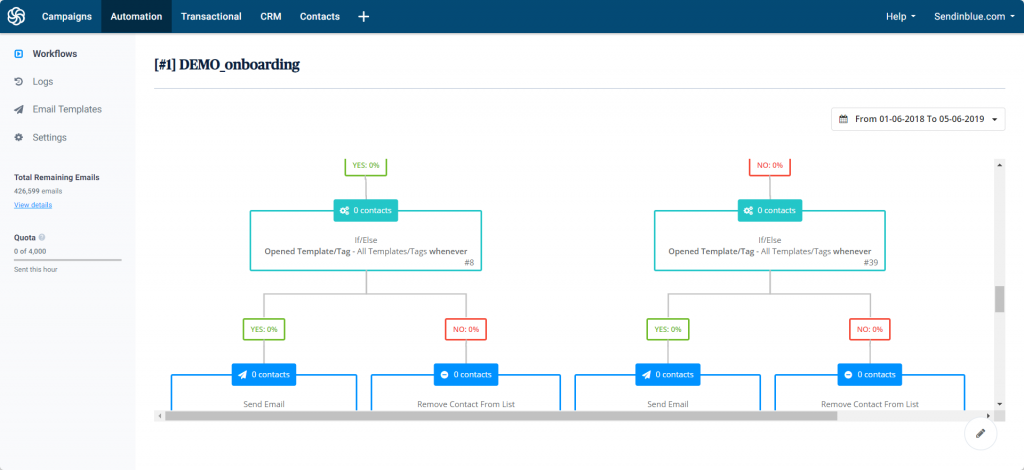
If you need an email marketing tool with a solid API to get your emails into inboxes with a good deliverability rate, Sendinblue’s pre-built developer recipes make it an excellent choice.
What are Sendinblue’s key features?
- Marketing automation
- SMS
- Live chat
- CRM
- Transactional email
- Landing pages
- Sign-up forms
- Facebook Ads
#4 Drip
A good option for smaller e-commerce stores
I think it’s fair to say that Drip’s focus is on smaller to medium-sized e-commerce businesses, whereas our next email marketing tool (Omnisend) seems better suited to the larger e-commerce stores.
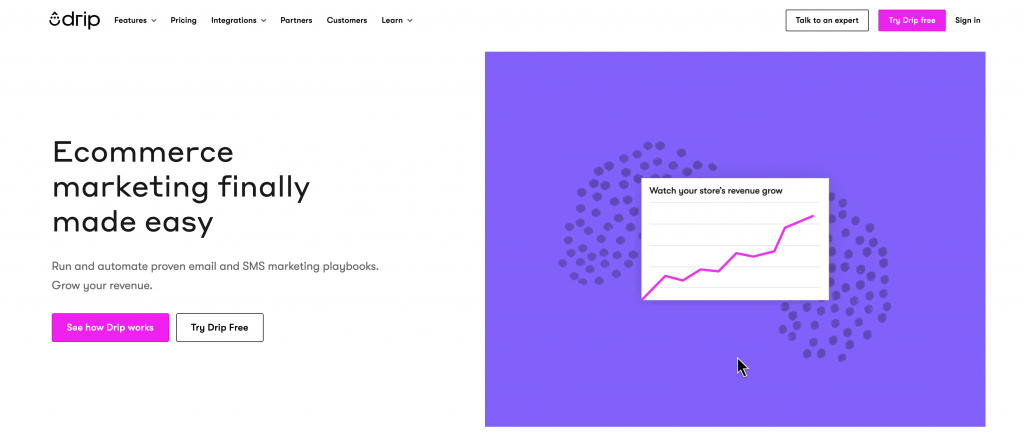
As you’d expect, Drip integrates deeply with all mainstream e-commerce platforms like Shopify, Magento and WooCommerce – as well as the more obscure and custom-made ones.
With built-in revenue analytics and tools to engage customers across multiple channels (from social channels to SMS) Drip is ideally positioned as a powerful tool for growing e-commerce stores.
Their pricing is also palatable, starting at $19/month for small list sizes.
What are Drip’s key features?
- Visual automation
- Email and SMS marketing
- Dynamic e-commerce content blocks
- Discount codes
- e-commerce Segmentation
- Retargeting
- e-commerce store integrations
- Reporting dashboards
- Split testing sequences
#5 Omnisend
A good option for medium-large e-commerce brands
Omnisend is quickly becoming one of the leading marketing platforms for e-commerce stores.
Designed to help e-commerce brands control their marketing across multiple channels, Omnisend offers automated email, SMS, push notifications, and most impressively, integrations with Google Ads, Instagram, Facebook Ads, Messenger, and WhatsApp – which they claim have 10X higher click-through rates than email.
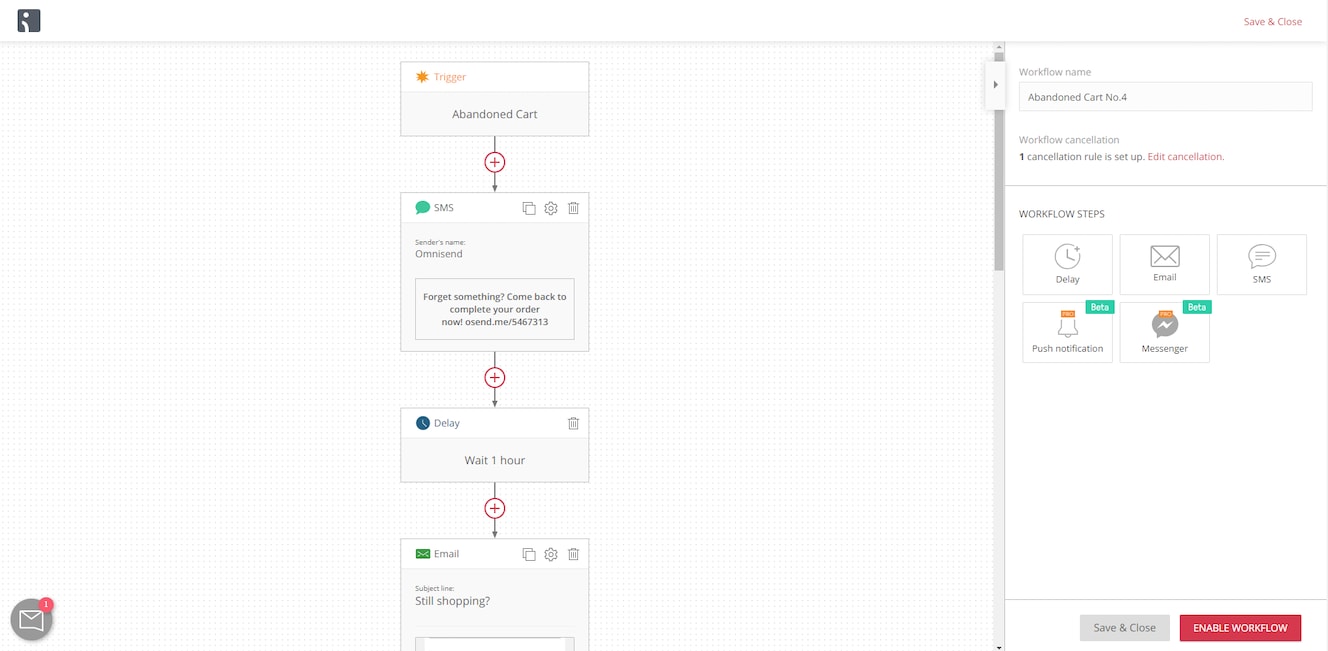
By focusing purely on e-commerce, Omnisend has built innovative email templates designed to reduce cart abandonment and drive repeat buyers. From ‘wheel of fortune’ offers to virtual scratch cards and birthday discounts, it’s evident that Omnisend’s built by a team intimately aware of what works in e-commerce.

As you’d expect of an e-commerce email marketing tool, Omnisend hooks into most e-commerce platforms, including Magento, Shopify, and BigCommerce. Where Omnisend goes one step further is in integrating with review, loyalty and help desk platforms, such as Yotpo, Smile.io, and ReCharge.
This not only enables Omnisend to report on how your campaigns impact sales, but enables you to trigger email, SMS and social campaigns based around your customer behaviour to reduce cart abandonment, increase return buyers, drive more product reviews, and more.
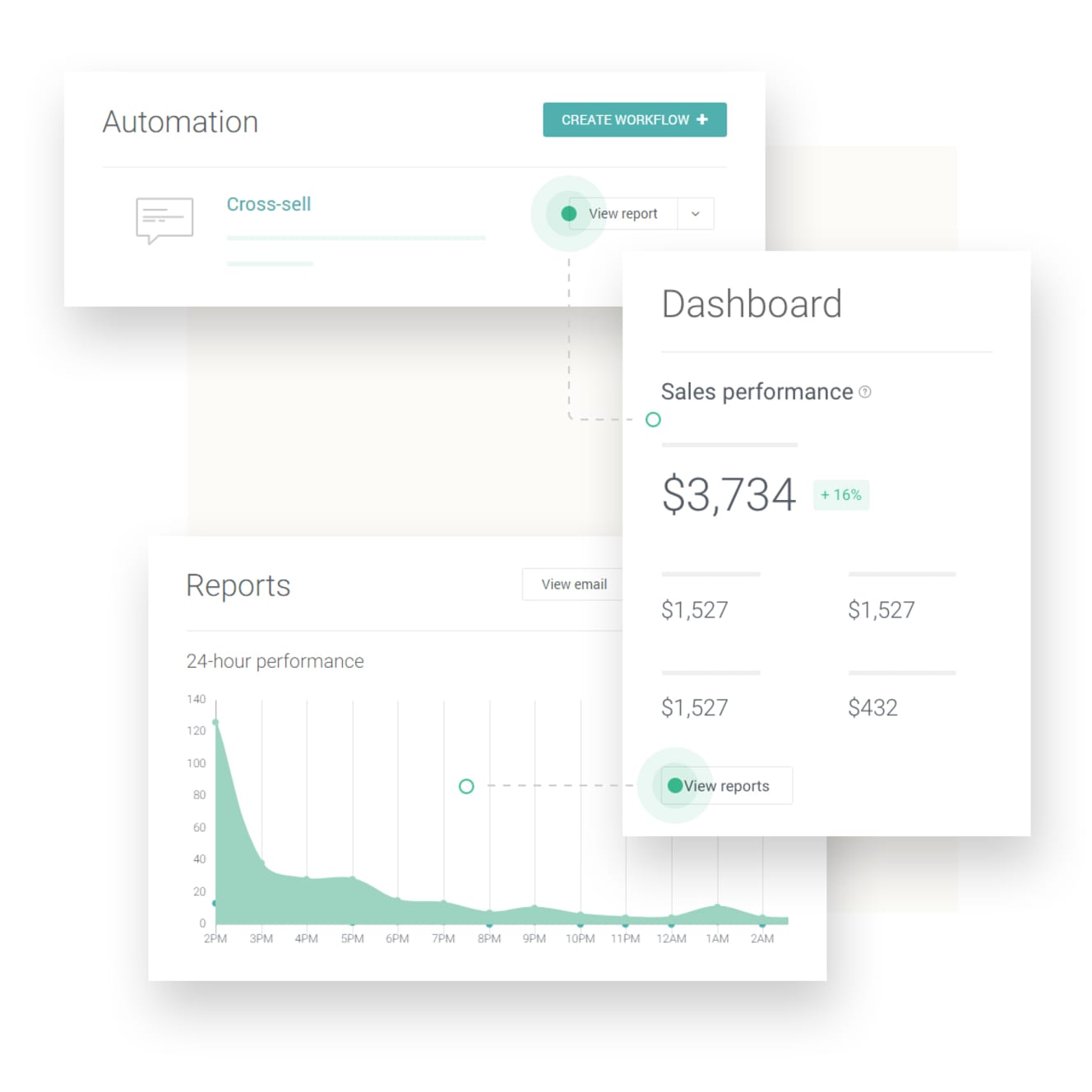
If you want the features that make Omnisend stand out, you’ll need a PRO account which starts at $199/month for up to 10,000 contacts. While not the cheapest, nor the easiest to use, Omnisend is a good option for e-commerce brands that want one multi-channel platform to rule them all.
What are Omnisend’s key features?
- Visual email builder
- Email, SMS and Push notifications
- Transactional and marketing emails
- Dynamic discount codes
- e-commerce Segmentation
- Retargeting
- Surveys and Polls
- Reporting
- Popups and forms – wheel of fortune, scratch cards etc.
- A/B Testing
#6 Autopilot
A good option for marketing automation
Gone are the days where email marketing is about sending bulk newsletters.
In today’s digital landscape, it’s essential for email marketing to be smart; sending the right messages to the right leads at the right time, automatically.
That’s why all of our top ten email marketing providers provide marketing automation. As the name would suggest, this is Autopilot’s forte. To boot, they have one of the best-designed canvases for building email automation sequences.

Anyone who has ever built an email automation sequence knows how quickly they can become confusing. Autopilot solves this in a rather quirky way, allowing you to annotate your automation sequences with emojis, stickers and explanations, making it easy for teams to collaborate on building sequences.
Yes, it can get messy – but I’d rather that and be able to understand what’s going on, than having beautiful automation sequences that take half an hour to interpret.
Another feature I love about Autopilot is its ability to trigger actions in your other tools inside Autopilot. This saves having to configure integrations using a tool like Zapier and makes your sequences much easier to understand.
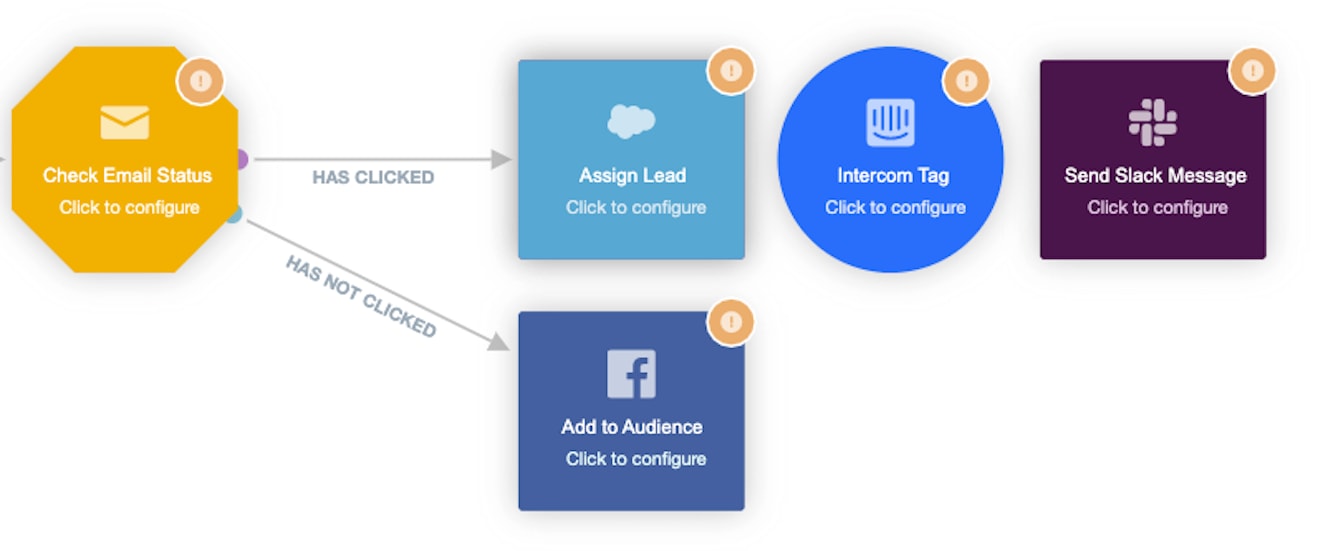
Autopilot’s reporting is also excellent, though, I’ll go into this in more detail in our section on reporting and analytics below.
Starting at $49/month for 2,000 contacts, Autopilot is far from the cheapest option, particularly considering that Autopilot does not offer an in-built CRM. However, Autopilot is extremely intuitive and great for teams that need to collaborate on powerful email automation sequences. If we had to move from ActiveCampaign, this is likely where we’d go.
#7 Benchmark
A good option for agencies
Benchmark is an interesting option for any business looking for a well-designed and easy-to-use email marketing tool.
While not quite as well known as other tools in the top ten, they’ve become an increasingly popular response to “Which tool are you moving to?” in our survey.
Benchmark do everything pretty well and are reasonably priced, but there’s one thing that really sets them apart from other email marketing tools – and that’s design.
Everything from their templates to the platform itself is beautifully-designed – and not just visually attractive, but great user experience. While that may seem trivial to some, it makes all the difference when it comes to understanding your data and creating the right impression with contacts.
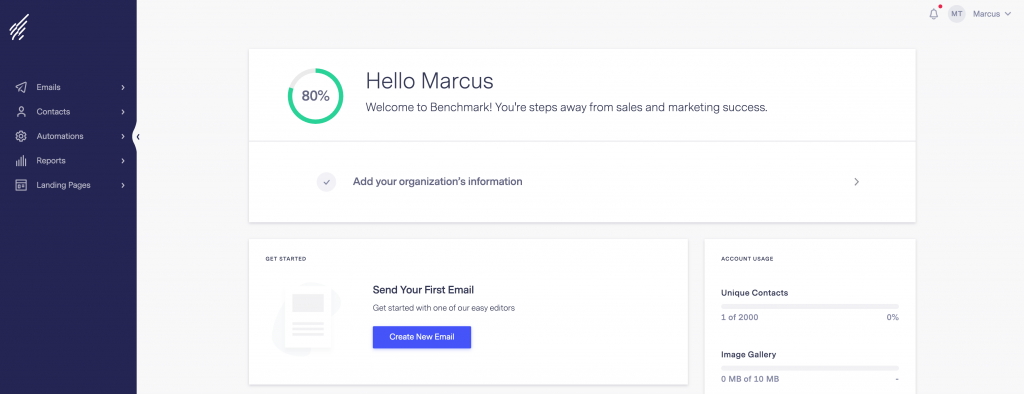
Benchmark is a good choice for any small business that needs simple, easy-to-use email marketing and automation software. It’s likely to be a particularly good choice for small agencies and consultancies where design is important both from a staff training perspective – and also providing a good experience for clients.
What are Benchmark’s key features?
- Visual email builder
- Marketing automation
- 1,500+ Integrations
- Landing pages
- Surveys and Polls
- Reporting
- Sign-up forms
- A/B Testing
Hit your growth goals
TrueNorth is the Growth Marketing Platform to focus, align, and track marketing in one place, with everything and everyone working towards your goal
#8 ConvertKit
A good option for bloggers
ConvertKit is a relatively simple email marketing tool used almost exclusively by bloggers and online course instructors to develop their personal brands.
Their platform has no bells or whistles. It doesn’t even have email templates, as ConvertKit encourages its users to send plain-text emails to increase engagement. As most of its users are individuals trying to build a personal brand this makes sense, but it does make ConvertKit a poor-fit for other use cases.
If you’re a creator that just needs a simple tool to serve your audience with regular content, there’s no better tool.
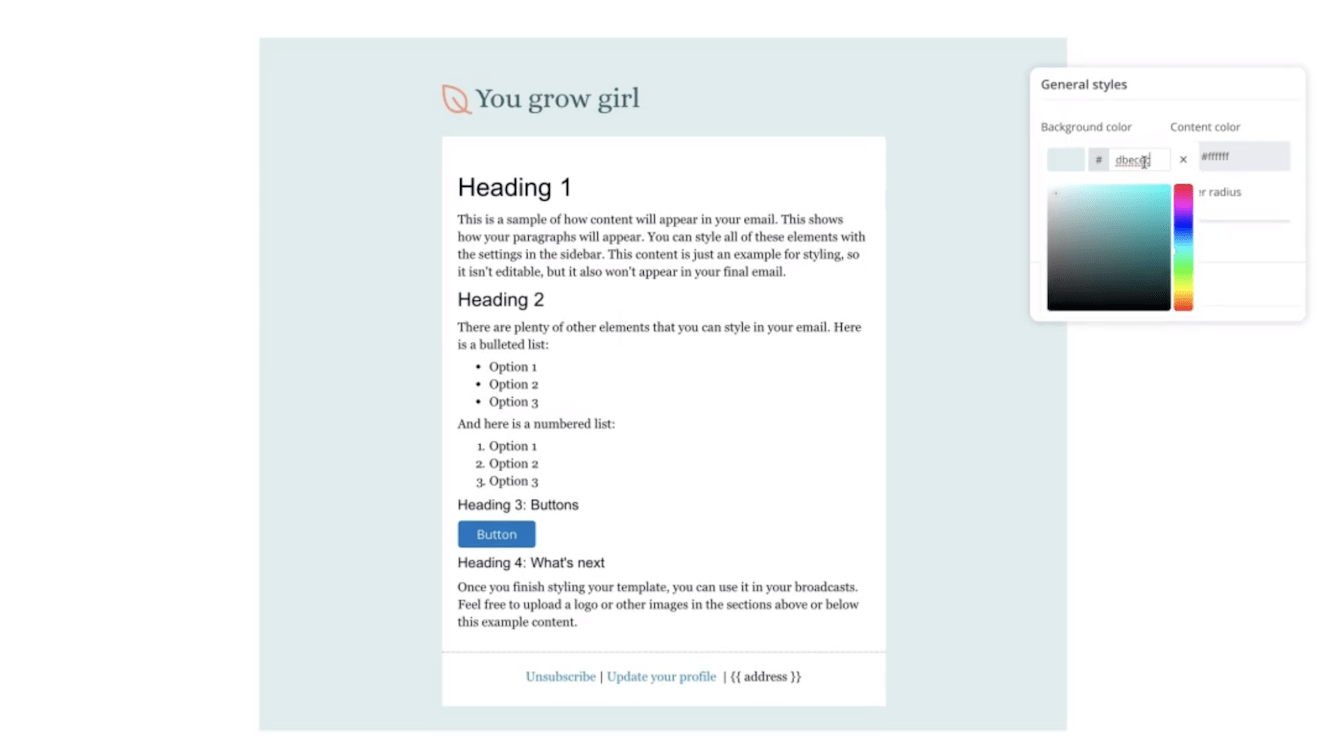
#9 MailerLite
A good option for personal projects
At the opposite end of the price spectrum, we have MailerLite, which is among the best email marketing tools for value for money (it’s free for sending up to 12,000 emails/month to less than 1,000 contacts).
Unlike the other beginner email marketing tools out there, MailerLite is a universally good tool irrespective of industry. Whether you’re growing a small charity, a side-hustle, or are a freelancer starting out, MailerLite offers everything you need to send bulk email marketing campaigns.
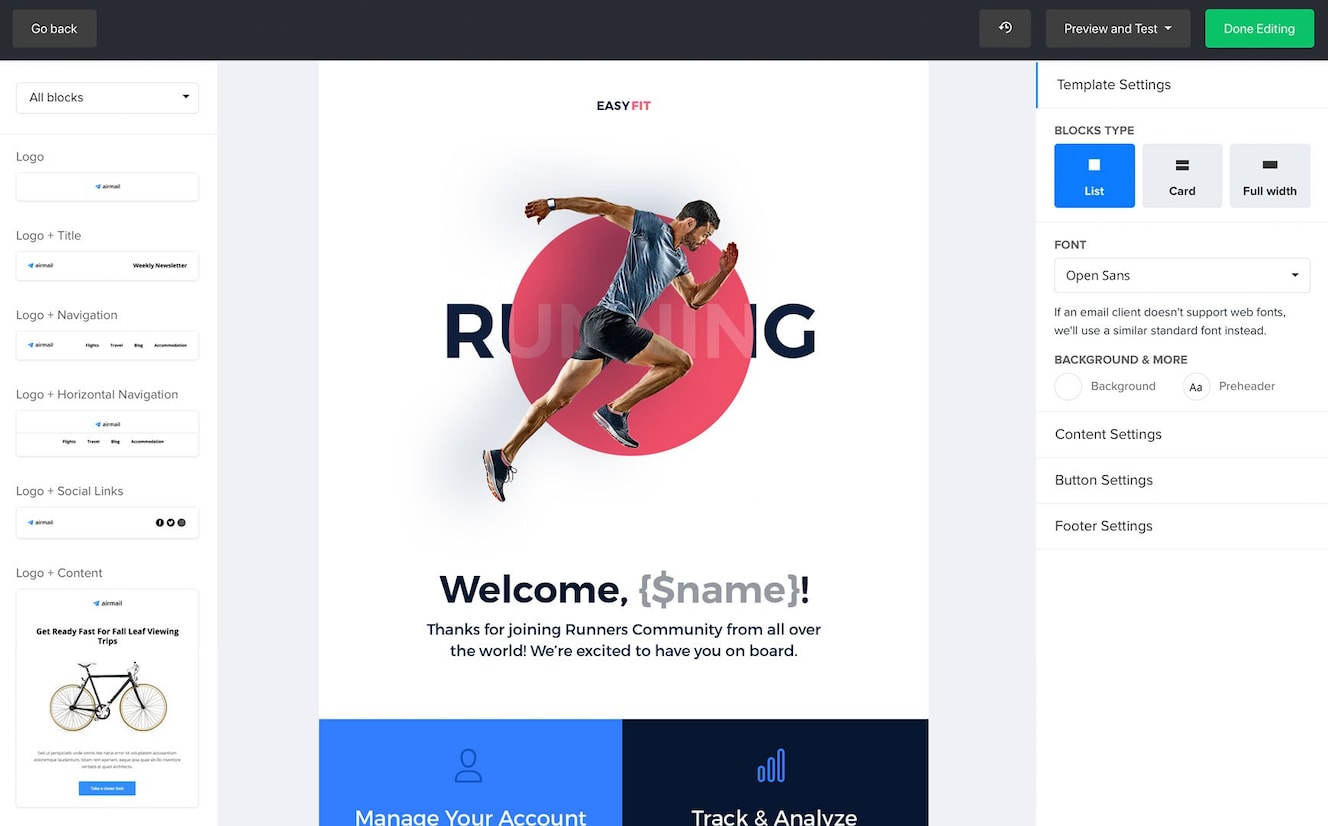
If you’re a small business, I’d suggest that a tool like ActiveCampaign may be a better fit, as they offer an in-built CRM and more advanced marketing features for roughly the same price.
For beginners and personal projects, where you just need to send beautiful email campaigns to engage your audience, MailerLite is ideal.
If you want to give MailerLite a spin, the folks there have kindly offered Venture Harbour readers an extended 30-day trial (instead of 14 days)
#10 EmailOctopus
A good option for developers
There’s long been a notion in email marketing that the most affordable way to send emails is using Amazon’s Simple Email Service (SES). Yet, the UI just isn’t built for marketing teams to create campaigns.
Many email marketing services have tried to bridge this gap – from Sendy to Moonmail, but they’ve often ended up either falling short on features or gravitating towards being more developer-centric.
EmailOctopus have nailed this balance.
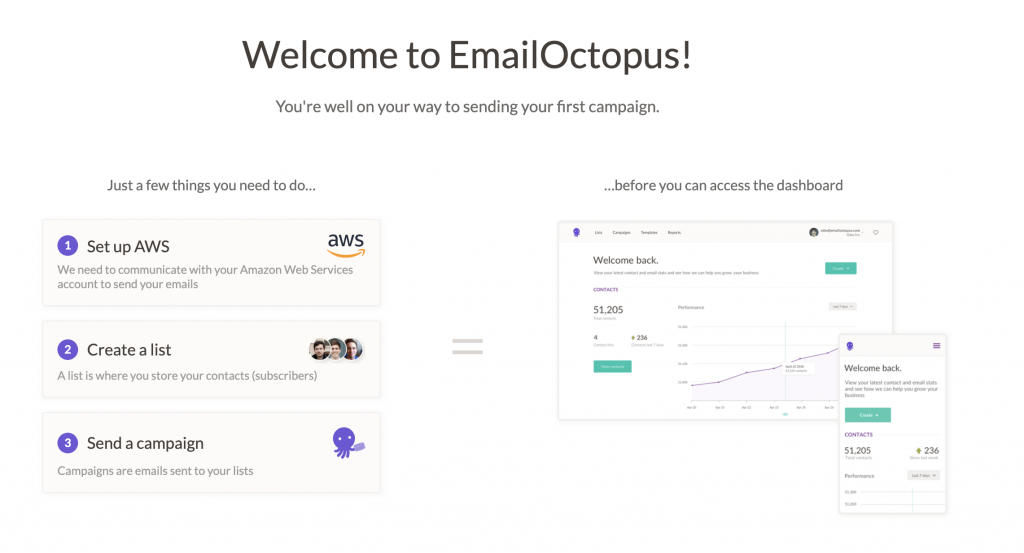
Conclusion
Let us know your thoughts in the comment section below.
Check out other publications to gain access to more digital resources if you are just starting out with Flux Resource.
Also contact us today to optimize your business(s)/Brand(s) for Search Engines
